This article will delve into what film noir is and its common tropes. We’ll offer pointers on how to write a film noir that both honours the traditions of the genre and puts a contemporary spin on the genre.
Wikipedia defines film noir as…
“a cinematic term used primarily to describe stylish Hollywood crime dramas, particularly those that emphasize cynical attitudes and sexual motivations”
What Is Film Noir?
Film Noir’s Origins…
They showed graphic depictions of sex and violence and had similar storylines BUT didn’t carry the same emphasis on ideology.
For Example…
- The 1981 remake of, The Postman Always Rings Twice, Directed by Bob Rafelson.
- This film was drastically different to the original. It was in colour and it overtly sexualised Cora and depicted sex as well as graphic violence (as opposed to the hint of such things).
- Despite being the same script, it did not carry the same moral significance.
Additionally, since ‘neo-noir’, it is possible to spot elements of film noir, and in particular, the figure of the femme fatale in current films. Gone Girl and The Favourite particularly stand out – We will discuss this in detail later on in the article.
Film Noir’s Stereotypical Traits and Tropes:
Film noir has an unmissable visual style.
- Black and white (typical of the time)
- Dark, low-key, chiaroscuro lighting
- Harsh shadows
- High-contrast mise en scene
- Ominous cinematography influenced by German Expressionism
- Voice-over narration
- Allusion over depictions (sex, violence etc.)
- Significant and telling iconography
- A femme fatale
- An anti-hero protagonist (typically male)
- Direct, simple dialogue
- Figure of authority (e.g. a police officer or lawyer)
Narrational Devices In Film Noir:
- First-person voice-over narration
- Flashbacks
- Narrative sequences/events clearly blocked out
Stereotypical Film Noir Characters:
- An anti-hero protagonist
- An investigator (voice of morality)
- A femme fatale figure who is the antagonist
- A husband (who does not fulfil the femme fatale’s needs- she wants to get rid of him and will manipulate the protagonist to assist her)
- An ‘ideal’, submissive female character- ‘the domestic woman‘
Film Noir’s Themes and Ideology:
Film noirs ALL have an underlying message. The messages are directly and obviously aimed at 1940s/1950s audiences. They serve as reminders of the male-dominated, patriarchal and misogynistic society which viewed women as domesticated wives or suspicious figures.
This gender clash is central to film noir films. The femme fatale symbolises this as she is a-typical. Other key themes/traits brought to the centre of the narrative of these films are:
- Violence and death
- Sex
- Power and patriarchy
Notable Film Noir Films:
- Sunset Boulevard (Wilder, 1950)
- The Postman Always Rings Twice (Wilder, 1946)
- The Big Sleep (Hawks, 1946)
- Double Indemnity (Wilder, 1944)
- Gilda (Vidor, 1946)
8 Steps To How To Write A Classical Film Noir:
Below we have listed a few key steps which will help you with writing your film noir.
The stages aren’t exhaustive, but they are important and should be included at some stage of your writing.
For the purpose of the article we will largely refer to The Postman Always Rings Twice and Double Indemnity
Step One – What’s The Story?
First and foremost, you need to decide on what your narrative is going to be. It might sound an obvious first stage, however it is essential! What is the point of your narrative? What do you want to achieve and is there a message you want to send?
A Few Ideas May Include…
- A wife wanting to escape her mundane life?
- Someone trapped in an unhappy marriage?
- A hitchhiker aspiring for a better life and love?
- Someone is on the run and they stumble into a femme fatale?
Whatever storyline you decide on, there are a few elements (as already mentioned) you must include to make it a classical film noir…
- A murder (typically of the husband)
- A femme fatale antagonist
- An anti-hero protagonist
- An ‘ideal’ woman
- A figure of authority (usually police officer or lawyer)
- Retribution – reinforcement of authority and patriarchy/ moral order typically via the death of the femme fatale
If you include the above elements, you have laid a solid groundwork for writing a film noir narrative by including the main tropes. You can avoid and lose some of these trope but having them as a guide may help lay initial ground.
Step Two – Who’s The Protagonist?
An obvious vital stage is to decide who your protagonist is. Typically they tend to (like most protagonists) desire something:
- A better life
- Love
- Work and security
The protagonist is manipulated and seduced by the femme fatale and is almost always an outsider and an outcast.
The femme fatale exploits them and draws them into a murder plot she has concocted in order to improve her life and achieve her want.
As with any character you write, you need to know them inside and out. And remember, they are not a hero.
Questions To Ask of the Protagonist:
- What’s their flaw? And how do you plan to reveal this to the audience?
- What’s their need vs want?
- They need to be seduced and easily manipulated- what is their weakness?
- What is their job?
- What is their background and where are they from?
Of course these are simplistic questions, but it is important to think about your protagonist in detail. Who are they?
- Why is the narrative centred around that specific individual?
The majority (if not all) of film noirs introduce the protagonist through their first-person voice-over narration.
- In The Postman Always Rings Twice Frank is introduced as a drifter looking for work.
- Whereas, in Double Indemnity, Walter is introduced as a man who is an insurance salesman.
Step Three – The Femme Fatale:
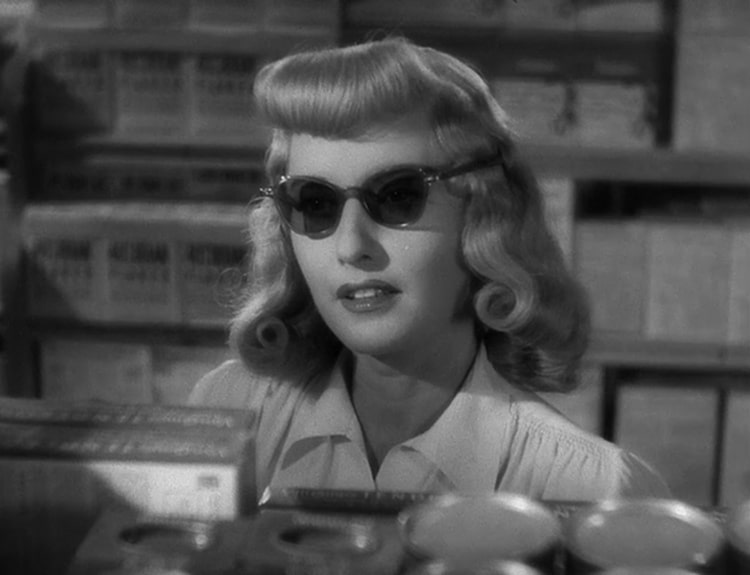
The temptress and seductress.
As mentioned, when you write a film noir, one of the main individuals, if not the most important figure, is the femme fatale.
According to Wikipedia…
“A femme fatale… is a stock character of a mysterious, beautiful, and seductive woman whose charms ensnare her lovers, often leading them into compromising, deadly traps”.
The femme fatale plays a vital role in impacting the protagonist‘s arc and actions as well as impacting the narrative chain of events.
From her first introduction her danger must be hinted at. This is often where camerawork becomes extremely important and effective.
- In The Postman Always Rings Twice, Cora is introduced through the camera tracking a lipstick rolling along the floor to her feet.
- Here, the camera tracks upwards along her body to reveal her face. Her introduction centres on her body and her awareness of her sexuality.
- It is important to note that the camera tracks the protagonist’s perspective, reinforcing his desire and interest in her sexually.
- In Double Indemnity, it is similar. Our introduction to Phyllis is sexualised – the camera tracks the protagonist’s perspective revealing her standing at the top of the stairs wearing only a towel.
As discussed, the role and function of the femme fatale is often to seduce and manipulate the protagonist into helping her achieve her goal. This goal typically defies social convention i.e. work, escape marriage etc.
Whilst these characteristics feel outdated and of their time, their narrative function is the lesson to take away. How can these stereotypical characteristics be subverted but still serve a similar narrative function? This is a key question in writing a contemporary film noir.
The introduction to the femme fatale is essential in hinting at the protagonist‘s weaknesses and flaws. Through her manipulation of the protagonist she will bring out their weaknesses. And this will ultimately have fatal consequences.
You should ask yourself:
- What is her want and desire? Money, love, work, freedom and independence?
- Is she a figure who goes against patriarchy? (Typically, she represents male fears of women dominating and working, disturbing the patriarchal order).
- What’s the end game- how will she get her retribution?
- What about her is so alluring?
- Why is she unhappy in her life?
Step Four – Make The Protagonist and Femme Fatale Compatible (She Needs To Fulfil the Protagonist’s Want):
First of all, you need to create a situation for the two characters to meet. As discussed above, the introduction to these characters is significant for the narrative development and character arcs.
- In The Postman Always Rings Twice, the protagonist is looking for a job and notices the sign for work at the diner and enters and thus, meets Cora, the boss’ wife.
- In Double Indemnity, Walter arrives at Phyllis’ house to inform her husband that he needs to renew his automobile insurance policy (a key element which will play a central role in the murder of Phyllis’ husband).
How are they coming to meet? Is he looking for work? Typically, there tends to be some involvement with the femme fatale’s husband or love interest. What this is, you can decide. However, it is important to create some form of relationship between the protagonist and the other love interest.
Compatibility and The Seduction:
It is important to create an initial first impression that the protagonist and femme fatale are compatible, making their desires and wants seem understandable.
- In The Postman Always Rings Twice, the initial meeting between Cora and Frank is frosty. She ignores him and applies makeup- appearing obsessed with her image and disinterested in Frank.
- Cora tells Frank she is unhappy in her marriage and desires to be rid of her husband. Frank wants to be with her and offers to assist her in getting rid of her husband so they can be together.
- Her aim is to gain control over the Twin Oaks, making it the diner she has always wanted.
- Cora seduces him by claiming she loves him when this is a facade to gain his alliance.
- In Double Indemnity, the two flirt, and Phyllis enquires about getting a life policy on her husband. Walter picks up on her hints at wanting him dead.
- He helps her murder her husband (strangles him) and covers it up by dressing as him then placing his body on train tracks.
- Her aim is to gain her husband’s money and live independently.
A key aspect to remember is that the femme fatale deceives the protagonist and promises if they remove the obstacle (her husband, for example), they will be together. Whereas, she really wants independence.
Step Five – Writing The Murder:
A central aspect to the film noir is the murder and crime aspect. Typically, the protagonist murders the Femme Fatale’s husband, the obstacle in the film.
The below are classic forms of murders from film noirs:
- Poison
- Strangulation
- Stabbing
- Shooting
For Example…
- In The Postman Always Rings Twice, the initial attempt at murdering Nick fails. Having planned for Cora to hit him on the head with a bag of rocks, a power outage occurs and Cora hits Nick, but not fatally.
- It is only later, when Nick catches Cora attempting to kill herself, he says he will kill Nick himself. The three of them drive to Santa Barbara, and on the way they get Nick drunk. Frank hits him over the head and drives the car off a cliff, with himself and Cora escaping.
- As already discussed, in Double Indemnity, Walter strangles Phyllis’ husband in the back of the car when they are on the way to the station. From here, he adopts his identity and boards the train, later jumping off and placing the real body on the tracks.
As you can see, the murders tend to be similar in practice. You can attempt to make this more complex. However, to write a classical film noir, simplicity is often the key.
Step Six – The Aftermath:
The aftermath of the murder is a key point in the narrative.
Despite appearing to be in the all-clear, the protagonist and femme fatale are always caught by the authorities and morality comes first.
However, the immediate aftermath typically tends to leave the protagonist and femme fatale in the all-clear momentarily.
For Example…
- In The Postman Always Rings Twice, Cora is held under suspicion and is charged with murder.
- However, Cora’s lawyer prevents her full confession from being released and she is released on probation with manslaughter charges.
- In Double Indemnity, the Chief, Mr Norton, is suspicious of Phyllis and believes she planned the murder and was having an affair.
- Lola, Phyllis’ step-daughter, blames her, so Walter starts seeing her in order to distract her
- A witness claims the person on the train was younger than the body found.
- Lola reveals Phyllis has been seeing her boyfriend, so Walter decides to kill her.
As you can see, it is important to create the idea of a return to normality, the idea that perhaps they will get away with it. However, this will always only last for a short period of time.
However, it is important to add in more layers of drama here:
- Is there another love interest?
- Was one of them hiding something/working for someone else?
- Will one of them die?
These are a few questions you should ask yourself as they make the narrative go from interesting, to compelling. After all, it is always more dramatic and engaging to add another layer to the story.
Step Seven – Retribution – Reinforcement Of Morality:.
The reinforcement of morality and order is conveyed through the villains (the protagonist and femme fatale) getting punished for committing murder.
For Instance This Can Be Seen In…
- In The Postman Always Rings Twice, Cora and Frank begin to run the diner the way Cora had always wanted. However, it stirs suspicions surrounding their involvement in Nick’s murder.
- They marry as a means of protecting themselves in court
- Cora leaves to visit her mother and whilst she is gone, Frank has an affair
- When Cora arrives she is blackmailed by the man who wrote her confession but Frank beats him up
- Frank’s affair comes out and she says she is pregnant
- They make up and go to the beach, but on the way back they have a car crash and Cora dies
- In Double Indemnity, as Walter states his intentions of killing her and framing Nino, he attempts to shoot Phyllis, she retaliates by shooting him in the shoulder, showing her true colours. She says she never loved him and was using him. He hugs her then shoots her dead.
The Take Away…
The Femme Fatale should die.
An important element from the 1940s film noirs is the femme fatale receiving her comeuppance for luring the seemingly ‘innocent’ protagonist to his doom.
Step Eight – How To End The Film Noir:
Typically, the noir follows a cyclical narrative, and ends with the protagonist‘s first person voice-over narration (the same as the narration at the beginning of the film).
Additionally, the protagonist will pay the price for being manipulated and seduced by the femme fatale.
For Example…
- In The Postman Always Rings Twice, Frank is convicted for killing Cora. The lawyer says that the evidence proves he was involve in killing Nick so would be sent to death row anyway.
- Through a voice over Frank says how both of them had to accept their fate and pay for their crimes.
- In Double Indemnity, Walter goes to his office and, whilst speaking into his dictaphone, confesses (a return to the film’s opening). He attempts to flee, but collapses as a result of being shot earlier by Phyllis.
The Take Away?
As mentioned above, the protagonist will suffer for their involvement with the femme fatale.
- What has the protagonist learnt? Have they grown and changed throughout the duration of the narrative?
- What message are you trying to convey within the film and its conclusion?
To Summarise…
- Mystery- there needs to be a clear sense of mystery within the narrative
- An outsider and outcast as the protagonist (not a hero)
- The femme fatale
- First-person narrative with flashbacks
- No happy ending
- A sense of the American Dream
But, What About Modern Film Noir and the Femme Fatale?
As earlier discussed, classic film noir is a product of 1940s/1950s society and values. Therefore, there is danger in writing a classic noir today of it turning into somewhat of a parody.
This is the same with 1980s neo-noir, which was very much a product of its time.
However, recent films feature aspects from classical film noirs, such as the figure of the femme fatale, which effectively, yet subtly, revive the genre.
There is no ‘set in stone’ path to follow to write a modern film noir. However, below we have listed a few films and their tropes which may inspire you write your own.
Gone Girl (2014)
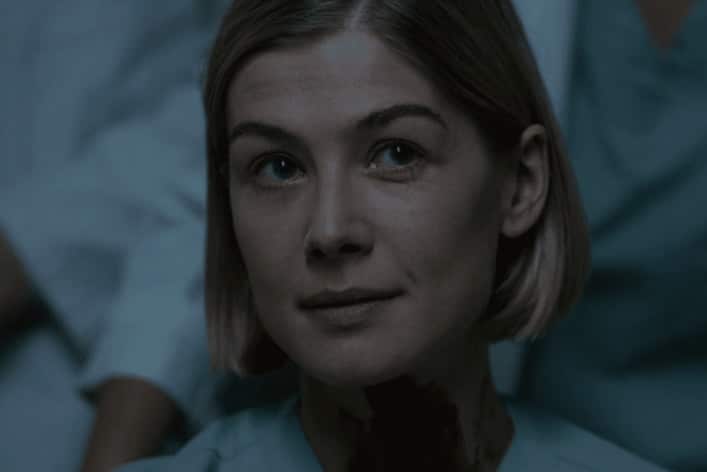
David Fincher’s 2014 adaptation of Gillian Flynn’s novel of the same name, is arguably a film noir and most significantly, includes a highly complex femme fatale figure.
The film is structured around dual protagonists, Amy and Nick. The first half of the narrative centres on Nick and is from his point of view, whereas the second half is from Amy’s.
To Summarise…
Nick arrives at his house to find his wife, Amy, missing and the house appears to be ‘broken in’.
The missing persons case soon becomes a murder investigation in which he becomes the main suspect (it is revealed he was having an affair, wanted a divorce and didn’t want Amy’s baby).
In the second half of the film it is revealed that Amy plotted her murder, framing Nick because of his unfaithfulness.
She alters her identity and watches Nick’s life slowly fall apart from afar. When she’s ready to return to the spotlight, she cold-bloodily murders her ex-boyfriend and manipulates and threatens Nick into staying with her by saying she is pregnant.
The Key Noir Aspects…
- Murder and the careful plotting
- Deception
- Betrayal (ironically it is the man who is betraying his wife as opposed to the woman in classical film noir)
- Replacing for a new, younger model (again it is the man not the woman)
- Flashbacks to younger, happier years – the trope of flashbacks is central to classical film noir
- Idealised female through the figure of ‘Amazing Amy’ – in classic noir the femme fatale was presented as the male ideal of a woman
- Nick doesn’t regard Amy as a person in the normal sense – he looks down to her and doesn’t treat her as a person. This is similar to the way men treated women in 1940s noir (i.e. Cora and Nick in The Postman Always Rings Twice).
- Amy gives up her job for Nick (she moves house for him- her own independence and life is taken away from her).
The Favourite (2018)
Likewise, there are hints at film noir in 2018’s The Favourite through Emma Stone’s character, Abigail.
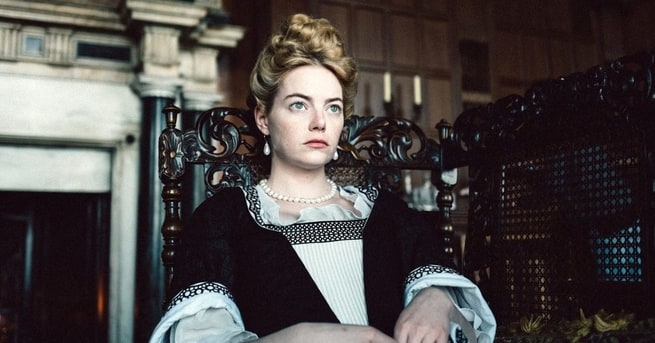
To Summarise…
The film centres on Queen Anne and her two love interests, Sarah and Abigail.
From the offset, we learn Anne and Sarah have a sexual relationship, but also that Sarah advises (tells) Anne how to run the country. This is soon disturbed by the arrival of Abigail, Sarah’s cousin, who has fallen on hard times.
Abigail, witnessing their relationship, decides to manipulate and use Anne as a means of gaining her status and wealth back. She soon wins over the Queen’s affections by becoming her lover, replacing Abigail.
With Anne’s favour, Abigail’s status is restored when she marries Colonel Masham, making her a Baroness again. From here, she uses her status to socialise and have affairs, neglecting Anne. Her evil nature is conveyed when she hurts one of Anne’s rabbits.
The film ends with Anne forcing Abigail to care for her.
The Key Noir Aspects…
- A femme fatale figure who manipulates Anne (in place of a man in classical noir) for her own vested interests of regaining her status and wealth.
- A femme fatale who will go to any lengths to get what she wants (sleeps with Anne, threatens Sarah and marries) and shows her true evil nature at the end of the film (hurts a rabbit).
- There is no real love between Abigail and Anne .
To Die For (1995)
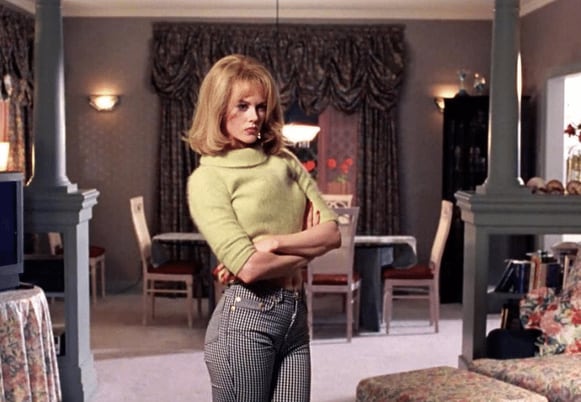
To Summarise…
The Gus Van Sant film To Die For centres on Suzanne Stone, a wannabe broadcast journalist who obsesses over fame and celebrity.
At the beginning of the film she marries Larry, who is part of a family restaurant business. She gets a job, having attempted to seduce the boss, at a local cable station as a secretary. She soon manipulates her way into becoming a weather reporter.
However, once Larry tells her to give up her career, she begins to plot how to get rid of him. Having visited a local school to get students to help with her documentary, she seduces and manipulates three pupils to help her with her murder.
She begins sleeping with James, using her sexuality to manipulate him into killing Larry on the basis that they will become a couple. However, as soon as the murder is complete she cuts ties and denies any relationship with the three to the police.
The three teenagers are arrested. Lydia wears a wire and gets Suzanne to confess. However, she is later released on bail.
Released, Suzanne loves the fame and tells fake stories about Larry to gain attention (drug addict etc). The two teenage boys are sentenced to life in prison.
The film ends with Larry’s father using the mafia to murder Suzanne and leave her underneath a frozen lake.
The Key Noir Aspects…
- A leading femme fatale figure who uses her sexuality to manipulate those around her, particularly James, as a means of achieving what she wants.
- A femme fatale who plots the murder of her husband so she has freedom and independence (she craves attention and praise).
- A femme fatale who dies as a result of her actions (manipulation and murder) – there is a clear sense of restoration of morality.
- There is a cyclical narrative.
- The film makes use of voice-over narration, but of the secondary characters not the protagonist
- There are multiple flashbacks (the entire film is a flashback).
Under The Skin (2013)

To Summarise…
Under the Skin centres on a woman (unnamed, but played by Scarlett Johansson) who goes around ‘collecting’ men. She lures them by seducing them with her female physique, and then disposes of them into a ‘void’.
She does this throughout the film. However, the film ends with her being attacked in a shelter by a logger. She runs into the woods, but he eventually rips her skin off her body, revealing her true alien form.
The Key Film Noir Aspects…
- The film centres on a femme fatale who uses her sexuality and body to seduce and exploit men.
- She is a deceitful and evil character who murders men she meets- fulfils her want.
- It makes use of dim-lighting and shadows to create an ominous look.
- She is sexualised and appears vampish.
- There is a strong sense of isolation throughout the film.
Ex Machina (2014)
To Summarise…
Ex Machina centres on Nathan Bateman, a Programmer who wins a competition to stay at CEO Nathan Bateman’s luxurious, isolated home for one week.
Here, Nathan asks Caleb to judge Ava (a female humanoid robot built by Nathan) and decide whether or not she has a conscience and can think.
As the narrative develops, it becomes clear that Caleb is using her to fulfil his sexual needs. At the same time, Caleb interviews Ava, and the two soon develop a mutual attraction.
Ava expresses an interest to flee to the outside world, but Nathan plans on wiping her memory. After seducing and manipulating Caleb into turning against Nathan (who she later kills after cutting the power out), she escapes having ‘repaired’ herself and abandons Caleb.
The Key Film Noir Aspects…
- The sense of isolation and ‘no escape’.
- A leading femme fatale figure (Ava) who manipulates and seduces the protagonist by telling him about her desire to escape and be with him if Nathan was gone.
- Nathan has created Ava as the idealised, perfect female form and exploits her to fulfil his sexual needs and desires.
However, unlike classical film noirs, Ex Machina‘s femme fatale is not punished for her behaviour. Instead, the film ends with her being given a chance at life in New York City.
We know she is evil, but she has gotten away with it. And we almost root for her as she’s taken advantage of the flawed men in her path.
This is a major difference between classical film noir and modern noir, highlighting how a modern film noirs can adapt to reflect more contemporary values.
The Beguiled (2017)
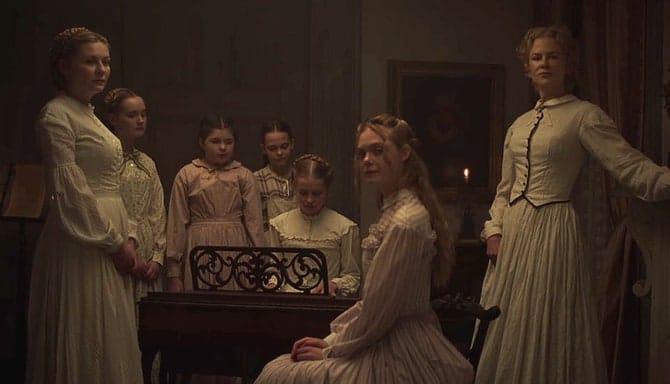
To Summarise…
The Beguiled centres on Martha Farnsworth, the Headteacher of a girls school, and her five pupils and one teacher during the American Civil War. When they find a wandering solider on their land, the women decide to care for him.
As the film progresses, he becomes a large presence at the school, gaining the attention of the girls and the teacher, Edwina. They all attempt to out do one another for his affections.
Already having relations with Edwina, one night she walks in on him with a student and in a rage, pushes him down the stairs and breaks his leg. When he wakes the next day, he has had the leg amputated by the women.
In a rage, he gets a hold of a gun and threatens the women. Later that evening, the women poison his food and he soon dies.
The last shot of the film is of the women dragging his body to the road.
The Key Film Noir Aspects…
- A wanderer/drifter figure.
- The idea of ‘evil women’ through all of the female characters.
- An isolated location (typical of classical noirs).
- Strong undertones of sexuality and the watchful male eye.
However…
The narrative is female-driven and the film does not condone the behaviour of the women- there is no restoration of morality. Therefore, despite it being a period film, it adopts more contemporary values.
So, Now It Is Your Turn To Write…
The above films are examples of modern films which have hints of noir through their employment of classical film noir tropes i.e. a femme fatale, use of location, plot, cinematography and lighting etc.
They are contemporary. They may not be classified as film noir’s but they most definitely fit in with the type and reflect an attempt at reviving the genre and Femme Fatale figure into modern film culture.
How To Write A Modern Femme Fatale:
As the examples show, the character of the femme fatale now goes beyond the film noir genre. She appears in:
- Dramas
- Thrillers (most similar to classical noir)
- Dark comedies
- Action and Science Fiction
What To Consider…
- Why is she there?
- What purpose does she serve?
- What role will she play on the narrative events?
- She doesn’t have to be your stereotypical femme fatale- make her different and subvert stereotype.
- How will she be modern? What will her values be? And will they speak to contemporary audiences?
A Few Final Pointers To Reiterate To Think About Before You Write A Film Noir:
- Why this story?
- Who is your protagonist and what do you want their arc to be?
- What will your femme fatale be like? Will she adhere to the classical film noir character archetype or will she be different?
- What is the message you want to convey with the film? Is there a point you’re trying to make with the film?
It’s a genre with a long and continuing legacy. And writing one requires an all important mix of following well established rules and bleeding in contemporary subjects, contexts and values.
When you write a film noir, use the traditions as guidelines to subvert and freshen up the genre and continue to push it forward.
- What did you think of this article? Share It, Like It, give it a rating, and let us know your thoughts in the comments box further down…
- Struggling with a script or book? Story analysis is what we do, all day, every day… check out our range of script coverage services for writers & filmmakers.
This article was written by Milly Perrin and edited by IS Staff
Get *ALL* our FREE Resources
Tackle the trickiest areas of screenwriting with our exclusive eBooks. Get all our FREE resources when you join 60,000 filmmakers on our mailing list!


“reinforcing the patriarchy via the death of the femme fatale who is the antagonist” What
Correct me if I’m wrong, but I think the femme fatale is more often a tragic character. Usually the rich client and the world of power they represent is the true antagonist (though they’re usually let go because their “punishment” of losing someone important due to their own greed has already happened to serve as the basis and eventual reveal of the plot – and also to reinforce that the world’s corruptness, the reason for the hero’s cynicism, can not be truly defeated.) The femme fatale and their self-destructiveness is presented as a victim of the same
“Under The Skin” isn’t even a noir, what the heck? It is however, an excellent satire/sci-fi/(feminist film?) that I often recommend to people. Same goes for Ex Machina. But you can’t shove it into the noir genre just because it has a woman killer or a woman who’s exploited. Those themes are more universal than the unreliable vamp and what they represent.
Admittedly I’ve not seen every movie on your list, I’m basing it on Raymond Chandler novels (who we should consider being the “creator” of the noir genre) and other authors after him. So this could be a fair criticism of post WWII cinema, but I think it’s wrong to equate that with the noir genre as a whole.
This was an awesome article, it helped me so much with my university film project. Thankyou!
Most welcome Tahj!
Great article. Is there any way a film noir can end with hope or positively?
Thanks Tee! Tradition would dictate…not…but tradition is always there to be re-invented.
I’d consider Lynch’s ‘Blue Velvet’ to be a modern noir, and despite the violence and depravity therein, it has a nice, hopeful ending.
The quality of the articles in Industrial Scripts is really good and I enjoy reading them. They’re witty, direct to the point and elucidative. This one helps me a lot. I realized there’s a small, though not harmless error here: The Postman Always Rings Twice was directed by Tay Garnett, not by Billy Wilder.
Congratulations and keep up the high quality work.
Enjoy the article and the insights given. Currently doing the final editing on a science fiction novella with noir aspects.
Be well,
AJY